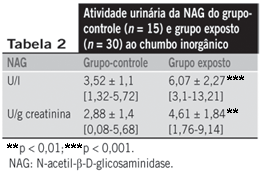OBJECTIVE: This study aimed to verify the enzymatic activity of N-acetyl-β-D-glucosaminidase (NAG) as a possible early biomarker of renal dysfunction due to occupational exposure to inorganic lead. MATERIALS AND METHODS: We selected a group of 30 males that had been exposed to inorganic lead in a battery factory in the state of Paraná. This group comprised those employees whose blood lead levels were below 40 mg/dl. The control group consisted of 15 healthy adults of similar age and gender compared with the exposed group. Blood lead concentrations, d-aminolevulinic acid levels and urinary NAG activity were measured. RESULTS AND DISCUSSION: It was shown that urinary NAG activity was significantly higher (p < 0.05, U test of Mann-Whitney) in the exposed group in comparison to the control group, and there was a significant negative correlation (p < 0.05, Spearman Rank Order correlation) between the biological indicator of lead exposure and urinary NAG activity. CONCLUSION: The results showed that the increase of urinary NAG activity may be used as an early biomarker of the exposure to inorganic lead.
Lead; N-acetyl-β-D-glucosaminidase; Biomarker; Occupational health; Urine





